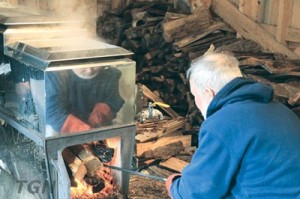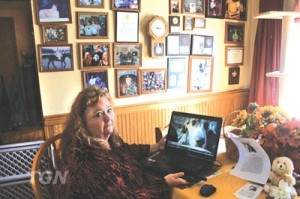This story appeared on October 18, 2014 in The Gardner News. It was part of a three part series talking to parents of addicts.
On Feb. 10, Joyce Fletcher woke up to a pounding on the door. It was still dark out, too early for good news.
“I came down the stairs, and I saw a police car, and I just lost it because I knew. I knew,” she said.
Her son, her baby, had died of a heroin overdose.
———
Six years earlier, Ms. Fletcher and her husband James learned their son Kevin was an addict the hard way. They had spent the day in New Hampshire watching their son play college football, and when they returned home their daughter’s then fiance was waiting in the kitchen.
“I thought ‘uh oh, something happened. Why is he here?’” said Ms. Fletcher. “And he said ‘something really bad happened, but it’s okay.’ And, of course, then you start shaking. He said ‘Kevin had an overdose.’”
Earlier that day — September 6, 2008 — Kevin, then 25, had been driving around with an old friend. When he went to get out of the car, he collapsed unconscious on the driveway. The friend started rescue breathing and called 911. When they arrived, EMTs revived Kevin with Narcan, a nasal spray that can reverse an opioid overdose. At first he didn’t want to go the hospital, but later relented.
“I think it scared him when they finally told him what happened,” his father said. “He couldn’t hide it anymore. “
Panicked, his parents spent the night on the phone trying to figure out what to do next. They called hotlines that didn’t work, asked bewildered doctors they knew for advice and researched detox centers on the internet.
By morning, they had settled on sending him to a clinic in California that charged $30,000 a stay.
“We thought 30, 60 days maybe, and he’d come back good as new, and life was going to go on like it used to,” Ms. Fletcher said.
“There was a small thought this might not work, but we thought for sure, he would be better,” she continued.
“I wish I knew people aren’t always looking out for the best interest of your child,” Ms. Fletcher said. “They just want your cash ahead of time.”
———
Later that day, the Fletchers put a resentful Kevin on a flight to the West Coast.
“Then we find out it’s all scientology, they give him high doses of meds and made him sweat. There was no treatment there,” Ms. Fletcher said. “I can’t believe I did that to my son.”
While it was happening, the Fletchers didn’t know how bad the center was. So Kevin went through the treatment, and his parents continued to believe he had come home fixed.
Until, his father caught him using the next day.
As time went on and Kevin went to more and more rehabs, his parents got smarter.
“Whether people know it or not, rehab is big business,” Ms. Fletcher said. “And it’s mostly unregulated.”
They learned to ask treatment centers if they were accredited by the Joint Commission of Hospital Accreditation.
They stopped feeling so pressured when centers said “there’s only one bed left” knowing that it probably wasn’t true.
They discovered the insurance wouldn’t cover their son’s treatment until he overdosed several times. And they traded their initial anger and frustration over the situation in for compassion towards their son.
“It’s an awful disease,” Ms. Fletcher said. “He struggled way, way more than we knew. He tried so hard to get better, and he just couldn’t … I would have traded places with him in a second. I would have done anything, but there wasn’t anything I can do.”
In total, they said they sent Kevin to at least 12 treatment facilities, including two stays at Hazelden treatment center.
Mr. Fletcher said they spent hundreds of thousands of dollars on treatment or “enough to send him to several privates schools and do a fifth year.”
“We’ve never added it up, but yeah we spent a lot of money,” he said.
———
In retrospect, Ms. Fletcher said, there were warning signs.
Growing up, Kevin had all the benefits of being part of an upper middle class home, Ms. Fletcher said. She stayed home with all three of her children, and both her and her husband volunteered in all their activities, not missing any events.
She always encouraged Kevin to invite his friends over, so she could make sure everything was okay. And when he was 16, they bought him a car, so he could always leave if things got out of hand while hanging out with friends.
“I guess what I am trying to say is that his life was normal, he had a great family, he had everything he needed and wanted. He lived in a nice house and he still suffered,” Ms. Fletcher said.
At Gardner High School, Kevin was on the football team and made captain of the baseball team.
He was happy, Ms. Fletcher recalled. It wasn’t until the end of his senior year that she started to notice changes, like a different group of friends.
“When you see them totally change friends, that’s a clue we didn’t know,” Mr. Fletcher said.
Kevin admitted to smoking pot, but his parents believed during college his drug use escalated. He went through periods of anxiety and depression. His grades slipped and he didn’t graduate after four years.
“I was in denial,” Ms. Fletcher said. “My gut was saying something was wrong and I didn’t listen to that because I didn’t want it to be that.”
He returned to Gardner and started working for his father. He lost weight, there were days he couldn’t get out of bed until mid afternoon and his mom noticed his pupils were often tiny.
Overall, he seemed depressed.
“I wish I had known to confront earlier … I don’t know if it would have changed anything. The hardest thing in the world is seeing your child dying and you’ve done everything and there’s nothing else you can do,” Ms. Fletcher said. “I think early intervention is important. The heavier the drug use gets, the worse it is going to turn out. A lot of them die. They’re either in prison or they die.”
A hair test, she said, would have been the best way to check.
———
In some ways, Kevin’s disease was the entire family’s. Ms. Fletcher, typically a very social person, retreated into herself.
She couldn’t handle being around a lot of people anymore.
“I was just so worn out from the fight,” she said. “Just as the addict isolates him or herself, so did I.”
She cried all the time and stopped smiling. This, in turn, strained her relationship with her husband, and her new distance hurt her other two kids.
“I was so sad all the time. I know it was hard for my other kids to see that,” Ms. Fletcher said. “They say you should release (your child with an addiction), not have any contact. I couldn’t do that to my baby. I know I maybe did things wrong. I couldn’t detach that much.”
She was waiting in dread, for a phone call saying her son was would never come home.
———
Kevin was struggling. He wanted to get better, his parents said, but he couldn’t.
At one point, his father recalled, he intentionally got himself kicked out of a rehab facility. The management decided to transfer him.
“They moved him to another facility in Desert Spring. They dropped him off outside with his suitcase, and he never bothered going in,” Mr. Fletcher said. “In 45 minutes he was high. That’s all it took, in a place he didn’t know, at 10 o’clock at night.”
The absolute worst period was the three months right before his last stay in Hazelden, when he was homeless living on the streets of Denver.
“It was horrible,” Ms. Fletcher said. She felt anxious and afraid all the time. “We didn’t know where he was. Sometimes he didn’t have a cell phone.”
When he did borrow someone’s phone to call home, he sounded awful, Ms. Fletcher said. He would beg to come home.
“We said ‘Yes Kevin, you can always come home, but you need help first,’” she said. “Finally, in order to save his life he called and asked for help.”
Mr. Fletcher flew to Denver the next day, and then drove him to Minneapolis and admitted him to Hazelden again.
———
There, Kevin began to get better. He had always wanted to be well, but his second stay was where things began to click. He worked through some of the shame and guilt he felt, and started to find joy without heroin for the first time in years.
“He called and told us ‘I never thought I could ever get better, and I do now. This place has given me hope,’” she said.
He moved into a halfway house. After four months of sobriety, he came home for Christmas. He had put on weight, was smiling, met his nephew for the first time. By all accounts, he seemed better, and Ms. Fletcher stopped waiting for the call telling her her son was dead.
“Seriously when he came home for Christmas I thought we had it licked,” Ms. Fletcher said. “We had hope. We had a lot of hope then. We really did.”
———
Two months later, he died of an overdose. He was in the bathroom at his sober living facility. Officials don’t know how long he had been using for, but suspect it was the first time since he had sobered up.
———
“What I wish I knew too is that I couldn’t save my son,” Ms. Fletcher said. “I wish I knew that. You spend so many years in anguish. Anytime Kevin said I want help we never turned our back on him. We were there. We never hid it from anybody we were always open about it. We don’t want Kevin’s life to be for nothing. He went to world class places … and we still couldn’t save him. He had to save himself.”
———
The Fletchers are now planning on starting a foundation to honor Kevin’s life and help other people going through what they did.
They also want people to know many detox centers, including Hazelden, offer scholarships to people who otherwise might not be able to afford treatment.
Parents looking for more resources can attend the Learn to Cope meetings Tuesday evening at Heywood Hospital. The group meets at 7 p.m.




